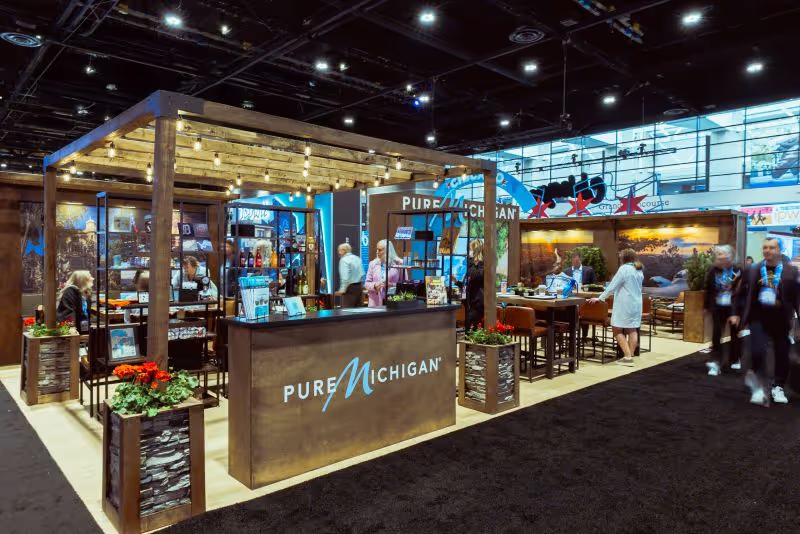Beyond Brand Exposure: How Experiential Marketing Creates Lasting Consumer Connections
Digital advertising competes for attention spans while consumers scroll past countless messages daily. Experiential marketing takes a different approach, transforming brand exposure from passive viewing into active participation. These face-to-face interactions create connections that resonate long after digital ads are forgotten, allowing brands to build relationships through tangible experiences rather than interruptive messaging.
Brand exposure through experiential marketing invites consumers to engage, explore, and interact with brands on their own terms. This approach generates measurable results through mobile tours, PR boxes, and live brand activations that create memorable moments. The following sections explore how strategic experiential approaches build authentic consumer relationships that drive business outcomes through direct engagement and personalized interactions.
Understanding Brand Exposure vs. Brand Awareness
Brand exposure and brand awareness serve different roles in consumer engagement, though they work together to build recognition and preference.
Brand exposure represents any moment when a brand becomes visible to potential consumers through:
- Advertisements across various media channels
- Social media posts and digital content
- Product placements and retail encounters
- Experiential events and activations
Brand awareness measures how well consumers recognize and recall a brand when making purchasing decisions. Awareness develops through repeated exposure combined with experiences that help consumers form opinions and preferences.
Traditional brand exposure methods often struggle with measurement challenges and limited engagement depth. A billboard creates exposure, but gauging its impact on consumer behavior remains difficult. Digital advertisements generate impressions, but consumers increasingly use ad blockers or ignore promotional content.
Experiential marketing bridges this gap by transforming exposure moments into awareness-building experiences. Face-to-face interactions create stronger brand recognition because they engage multiple senses simultaneously. When consumers touch products, participate in activities, or speak with brand representatives, they form richer memories than passive exposure can create. This enhanced brand visibility through direct interaction improves recall and creates positive associations that influence purchasing decisions.
The Power of Experiential Marketing for Brand Exposure
Experiential marketing creates direct consumer connections through immersive experiences that traditional advertising cannot replicate. These interactions allow brands to demonstrate value propositions naturally while building authentic relationships with target audiences. Consumers choose their engagement level, creating more meaningful connections than forced exposure through interruptive advertising.
This approach delivers several advantages over traditional brand exposure methods:
- Direct Consumer Access: Face-to-face interactions that bypass digital advertising clutter and ad-blocking technology
- Measurable Engagement: Direct metrics like conversation duration and product interaction rates provide concrete ROI data
- Multisensory Experiences: Physical interactions create stronger memory formation than visual exposure alone
- Authentic Advocacy: Satisfied participants become organic brand ambassadors through word-of-mouth sharing
While traditional advertising relies on reach estimates and impression counts, experiential campaigns generate direct engagement metrics that demonstrate actual consumer interest and participation. This data helps brands understand which elements resonate most with their target audiences and optimize future campaigns accordingly.
Three Core Strategies for Maximum Brand Exposure
Experiential marketing encompasses three primary approaches that transform brand exposure from passive viewing into active participation. These strategies create direct consumer connections while delivering measurable results across diverse marketing objectives:
Mobile Tours: Taking Your Brand Directly to Consumers
Mobile tours deliver brand experiences directly to target demographics through strategic route planning and location selection. This approach removes barriers between brands and consumers while creating opportunities for authentic engagement.
The Coach Tabby Tour exemplified this approach through a custom-wrapped shipping container topped with an oversized Tabby purse, creating instant brand exposure on college campuses while encouraging social sharing through interactive elements and photo opportunities.

Mobile tours provide several advantages for brand exposure:
- Strategic Routing: Research-driven location selection based on demographic concentrations and market potential
- Face-to-Face Engagement: Direct conversations that build brand awareness through personal connections
- Geographic Flexibility: Ability to reach consumers in their preferred locations and test new markets
- Immediate Feedback: Real-time consumer insights that inform future marketing campaigns
This direct approach generates qualified interactions that influence purchasing decisions while creating memorable brand moments.
PR Boxes: Extending Brand Exposure Beyond Events
PR boxes, also called experience kits or new product boxes, deliver brand moments directly to consumers through carefully curated packages that tell brand stories and create lasting impressions. These customized solutions extend brand exposure beyond live events while maintaining personalization and quality control.
The Adidas influencer kit demonstrates this strategy by combining iconic products with lifestyle accessories tailored to each recipient, creating personalized brand exposure that encourages content creation and extends reach through influencer networks.

PR boxes offer multiple benefits for brand engagement:
- Customization Options: Personalized elements like signed letters and monogrammed items that reflect brand identity
- Tiered Solutions: Different experience levels within single campaigns to maximize budget efficiency
- Direct Delivery: Brand moments that reach consumers in their personal spaces
- Social Amplification: Shareable unboxing experiences that extend reach through communication channels
This approach creates aspirational elements that encourage engagement while demonstrating value for consumer relationships.
Live Brand Activations: Creating High-Impact Brand Moments
Live brand events create immersive brand environments where consumers can explore products and services while participating in memorable experiences. These activations generate immediate brand exposure while providing opportunities for deeper engagement and relationship building.
The Pure Michigan trade show booth showcased this strategy through a modular design inspired by Michigan's heritage, featuring premium materials and thoughtful spaces that created brand exposure while fostering meaningful connections with trade show attendees.

Brand activations deliver impact through several elements:
- Immersive Environments: Multi-sensory spaces that transport consumers into brand narratives
- Consumer Journey Mapping: Thoughtful touchpoint design from initial awareness through follow-up
- Interactive Demonstrations: Hands-on product experiences that showcase value propositions
- Professional Execution: Quality standards that reinforce brand messaging across all interactions
This comprehensive approach creates lasting impressions while generating measurable engagement metrics.
Measuring Brand Exposure Success in Experiential Marketing
Successful experiential brand exposure requires comprehensive measurement that goes beyond traditional reach metrics. Direct engagement tracking provides concrete data about consumer interactions, including conversation duration, product trial rates, and lead generation numbers. These metrics demonstrate actual brand exposure effectiveness rather than estimated impressions.
Traditional reach metrics focus on potential exposure through circulation numbers or estimated viewership. Experiential campaigns generate concrete engagement data that reveals actual consumer behavior and interest levels. Brands can track how many people participated in demonstrations, requested additional information, or shared experiences on social media platforms.
Key Performance Indicators for Experiential Campaigns:
- Engagement Duration: Time spent interacting with brand elements and representatives
- Lead Quality: Contact information collected and subsequent conversion rates
- Social Media Amplification: User-generated content and organic sharing metrics
- Product Trial Rates: Hands-on interaction and demonstration participation
- Brand Recall Improvement: Pre- and post-campaign awareness studies
Consumer sentiment analysis and feedback collection provide qualitative insights that complement quantitative metrics. Direct feedback reveals what resonated with participants while identifying areas for improvement.
Activate conducts thorough post-event analysis for every client activation, providing comprehensive recap reports that document performance against objectives. This review process gives clients actionable insights while demonstrating a clear return on investment.
Best Practices for Effective Brand Exposure
Successful experiential brand exposure requires careful planning and execution across multiple touchpoints. These practices help brands maximize their investment while creating memorable experiences that resonate with target audiences:
- Maintain Brand Consistency: Visual elements, messaging, and staff communication should align across all touchpoints to reinforce recognition
- Research Target Demographics: Understanding audience preferences, behaviors, and motivations guides location selection and experience design
- Plan Strategic Integration: Experiential campaigns should complement existing marketing efforts rather than creating conflicting messages
- Focus on Quality Control: Attention to detail in visual design, staff training, and operational logistics creates positive brand impressions
- Design Clear Consumer Journeys: Map every touchpoint from initial awareness through post-event follow-up to optimize engagement flow
- Train Staff Thoroughly: Brand representatives should understand product knowledge, messaging, and customer service protocols
- Establish Measurement Criteria: Define success metrics before launch to track performance against business objectives
- Create Shareable Moments: Design photo-worthy installations and experiences that encourage organic social media sharing
- Prepare Contingency Plans: Develop backup protocols for weather, technology failures, and other potential disruptions
- Collect Real-Time Feedback: Monitor participant reactions and adjust experiences accordingly during activation periods
Activate: Transforming Brand Visions Into Experiences
Activate specializes in creating meaningful brand connections through three core services: mobile tours, PR boxes, and live brand activations. Our work combines strategic planning with careful execution, delivering experiences that resonate with audiences across diverse markets and demographics.
Our capabilities encompass every aspect of experiential marketing, from initial concept development through final execution and performance analysis. This integrated approach helps each activation achieve its objectives while maintaining brand consistency across all touchpoints.
From our 75,000 square foot facility in Metro Detroit, we deliver turnkey operations including fulfillment, fabrication, and logistics services. Our women-owned business handles every detail with in-house woodworking, custom aluminum structure modifications, specialty decorating services, and comprehensive shipping support. This attention to detail allows brands to focus on their objectives while we manage the execution.
Connect with us to explore how mobile tours, PR kits, and live brand activations can help bring your marketing vision to life.
Frequently Asked Questions
What makes experiential marketing more effective than digital advertising for brand exposure?
Experiential marketing creates direct, face-to-face interactions that engage multiple senses and allow consumers to choose their engagement level, resulting in stronger memory formation and brand recognition than passive digital exposure.
How do you measure the success of experiential brand exposure campaigns?
Success measurement includes direct engagement metrics, lead generation numbers, social media reach, consumer sentiment analysis, and long-term brand recognition studies that connect experiential interactions to business outcomes.
